Cultural Safety Reflection: Nursing Practice and Aboriginal Care
VerifiedAdded on 2023/01/13
|7
|1932
|82
Report
AI Summary
This report provides a student's reflection on cultural safety within the context of nursing practice, particularly concerning the care of Aboriginal and Torres Strait Islander peoples. The student draws on insights from Coffin (2007) and other readings to define cultural safety as a journey encompassing cultural awareness, sensitivity, and competence. The reflection outlines the student's evolving understanding of cultural safety, emphasizing the importance of considering culture's influence on health, questioning the 'whiteness' of nursing, and applying the five principles of cultural safety. The student highlights the significance of incorporating cultural safety into practice by focusing on patient empowerment, understanding cultural diversity, and improving healthcare quality. The student also outlines a strategy for providing culturally safe care, including the adoption of a PPP strategy (partnership, participation, and protection) to support the wellbeing of Aboriginal and Torres Strait Islander peoples. The reflection concludes with the student's commitment to addressing inequalities and providing effective, culturally secure nursing care.
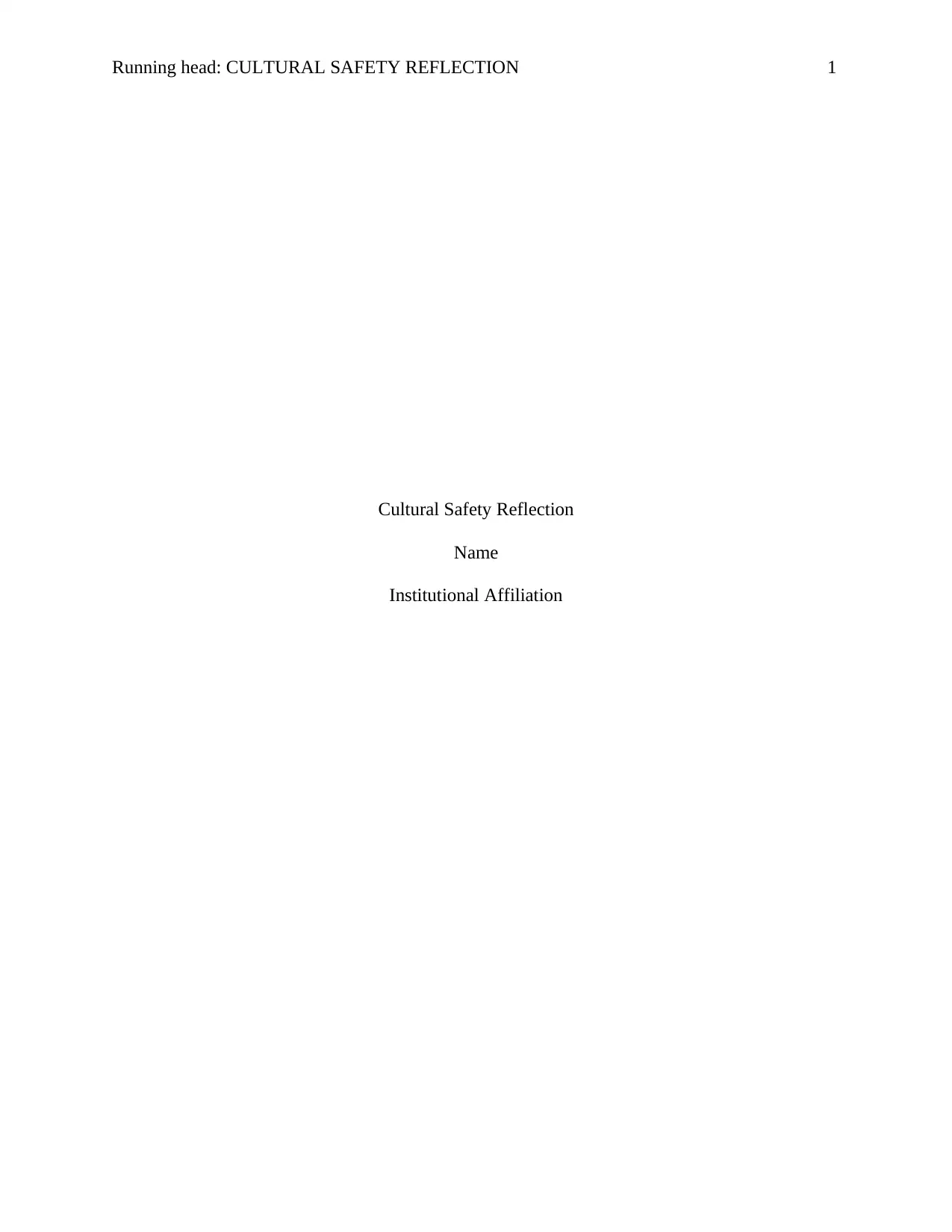
Running head: CULTURAL SAFETY REFLECTION 1
Cultural Safety Reflection
Name
Institutional Affiliation
Cultural Safety Reflection
Name
Institutional Affiliation
Paraphrase This Document
Need a fresh take? Get an instant paraphrase of this document with our AI Paraphraser
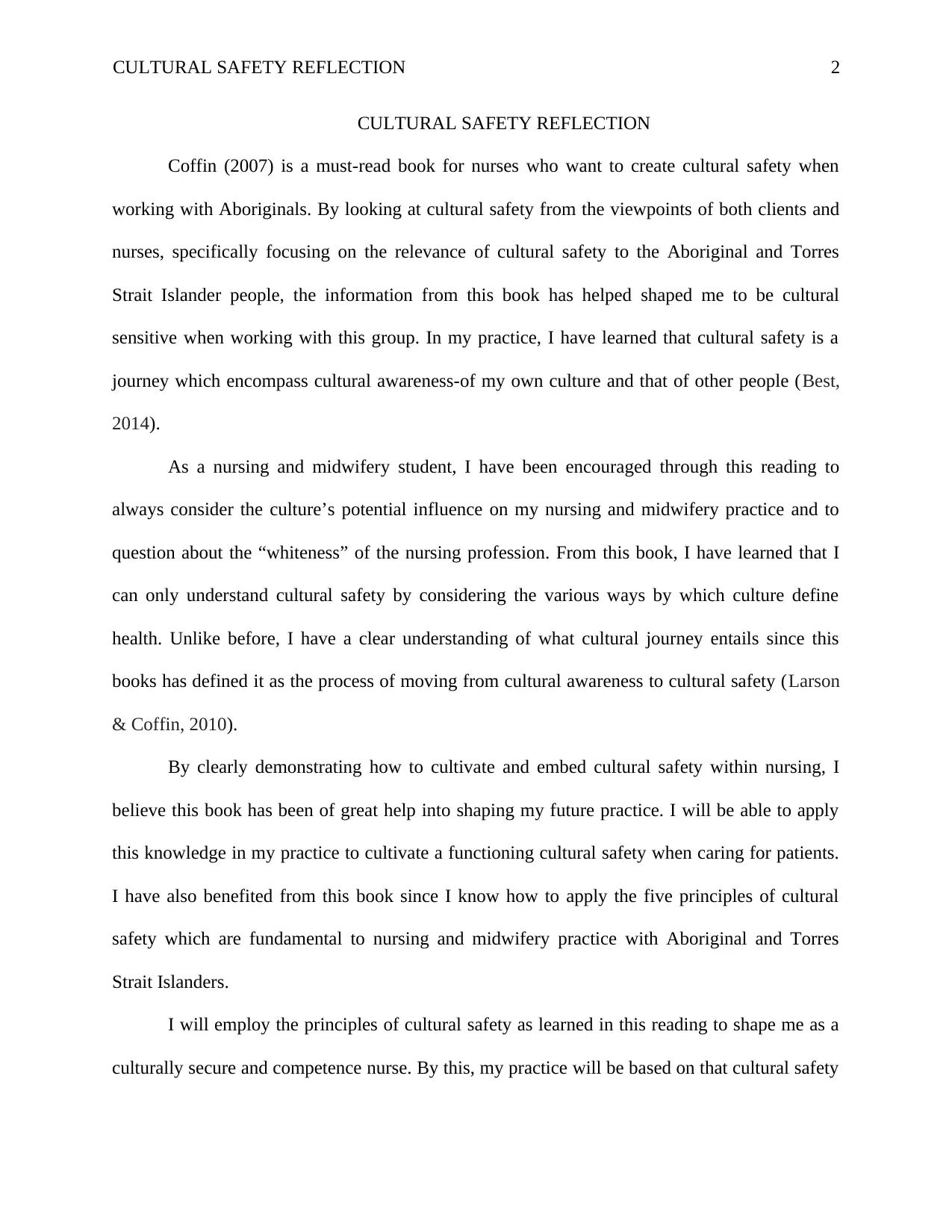
CULTURAL SAFETY REFLECTION 2
CULTURAL SAFETY REFLECTION
Coffin (2007) is a must-read book for nurses who want to create cultural safety when
working with Aboriginals. By looking at cultural safety from the viewpoints of both clients and
nurses, specifically focusing on the relevance of cultural safety to the Aboriginal and Torres
Strait Islander people, the information from this book has helped shaped me to be cultural
sensitive when working with this group. In my practice, I have learned that cultural safety is a
journey which encompass cultural awareness-of my own culture and that of other people (Best,
2014).
As a nursing and midwifery student, I have been encouraged through this reading to
always consider the culture’s potential influence on my nursing and midwifery practice and to
question about the “whiteness” of the nursing profession. From this book, I have learned that I
can only understand cultural safety by considering the various ways by which culture define
health. Unlike before, I have a clear understanding of what cultural journey entails since this
books has defined it as the process of moving from cultural awareness to cultural safety (Larson
& Coffin, 2010).
By clearly demonstrating how to cultivate and embed cultural safety within nursing, I
believe this book has been of great help into shaping my future practice. I will be able to apply
this knowledge in my practice to cultivate a functioning cultural safety when caring for patients.
I have also benefited from this book since I know how to apply the five principles of cultural
safety which are fundamental to nursing and midwifery practice with Aboriginal and Torres
Strait Islanders.
I will employ the principles of cultural safety as learned in this reading to shape me as a
culturally secure and competence nurse. By this, my practice will be based on that cultural safety
CULTURAL SAFETY REFLECTION
Coffin (2007) is a must-read book for nurses who want to create cultural safety when
working with Aboriginals. By looking at cultural safety from the viewpoints of both clients and
nurses, specifically focusing on the relevance of cultural safety to the Aboriginal and Torres
Strait Islander people, the information from this book has helped shaped me to be cultural
sensitive when working with this group. In my practice, I have learned that cultural safety is a
journey which encompass cultural awareness-of my own culture and that of other people (Best,
2014).
As a nursing and midwifery student, I have been encouraged through this reading to
always consider the culture’s potential influence on my nursing and midwifery practice and to
question about the “whiteness” of the nursing profession. From this book, I have learned that I
can only understand cultural safety by considering the various ways by which culture define
health. Unlike before, I have a clear understanding of what cultural journey entails since this
books has defined it as the process of moving from cultural awareness to cultural safety (Larson
& Coffin, 2010).
By clearly demonstrating how to cultivate and embed cultural safety within nursing, I
believe this book has been of great help into shaping my future practice. I will be able to apply
this knowledge in my practice to cultivate a functioning cultural safety when caring for patients.
I have also benefited from this book since I know how to apply the five principles of cultural
safety which are fundamental to nursing and midwifery practice with Aboriginal and Torres
Strait Islanders.
I will employ the principles of cultural safety as learned in this reading to shape me as a
culturally secure and competence nurse. By this, my practice will be based on that cultural safety
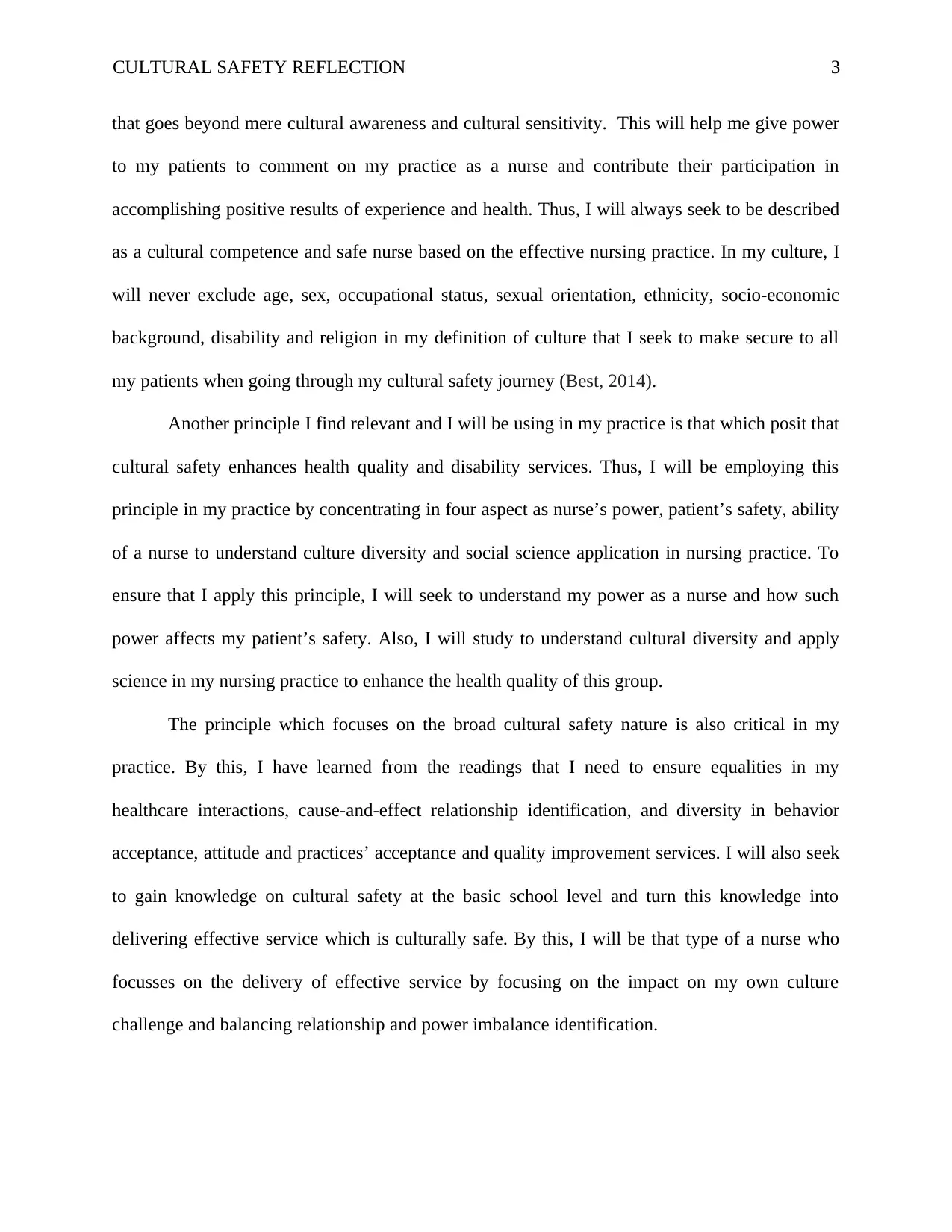
CULTURAL SAFETY REFLECTION 3
that goes beyond mere cultural awareness and cultural sensitivity. This will help me give power
to my patients to comment on my practice as a nurse and contribute their participation in
accomplishing positive results of experience and health. Thus, I will always seek to be described
as a cultural competence and safe nurse based on the effective nursing practice. In my culture, I
will never exclude age, sex, occupational status, sexual orientation, ethnicity, socio-economic
background, disability and religion in my definition of culture that I seek to make secure to all
my patients when going through my cultural safety journey (Best, 2014).
Another principle I find relevant and I will be using in my practice is that which posit that
cultural safety enhances health quality and disability services. Thus, I will be employing this
principle in my practice by concentrating in four aspect as nurse’s power, patient’s safety, ability
of a nurse to understand culture diversity and social science application in nursing practice. To
ensure that I apply this principle, I will seek to understand my power as a nurse and how such
power affects my patient’s safety. Also, I will study to understand cultural diversity and apply
science in my nursing practice to enhance the health quality of this group.
The principle which focuses on the broad cultural safety nature is also critical in my
practice. By this, I have learned from the readings that I need to ensure equalities in my
healthcare interactions, cause-and-effect relationship identification, and diversity in behavior
acceptance, attitude and practices’ acceptance and quality improvement services. I will also seek
to gain knowledge on cultural safety at the basic school level and turn this knowledge into
delivering effective service which is culturally safe. By this, I will be that type of a nurse who
focusses on the delivery of effective service by focusing on the impact on my own culture
challenge and balancing relationship and power imbalance identification.
that goes beyond mere cultural awareness and cultural sensitivity. This will help me give power
to my patients to comment on my practice as a nurse and contribute their participation in
accomplishing positive results of experience and health. Thus, I will always seek to be described
as a cultural competence and safe nurse based on the effective nursing practice. In my culture, I
will never exclude age, sex, occupational status, sexual orientation, ethnicity, socio-economic
background, disability and religion in my definition of culture that I seek to make secure to all
my patients when going through my cultural safety journey (Best, 2014).
Another principle I find relevant and I will be using in my practice is that which posit that
cultural safety enhances health quality and disability services. Thus, I will be employing this
principle in my practice by concentrating in four aspect as nurse’s power, patient’s safety, ability
of a nurse to understand culture diversity and social science application in nursing practice. To
ensure that I apply this principle, I will seek to understand my power as a nurse and how such
power affects my patient’s safety. Also, I will study to understand cultural diversity and apply
science in my nursing practice to enhance the health quality of this group.
The principle which focuses on the broad cultural safety nature is also critical in my
practice. By this, I have learned from the readings that I need to ensure equalities in my
healthcare interactions, cause-and-effect relationship identification, and diversity in behavior
acceptance, attitude and practices’ acceptance and quality improvement services. I will also seek
to gain knowledge on cultural safety at the basic school level and turn this knowledge into
delivering effective service which is culturally safe. By this, I will be that type of a nurse who
focusses on the delivery of effective service by focusing on the impact on my own culture
challenge and balancing relationship and power imbalance identification.
⊘ This is a preview!⊘
Do you want full access?
Subscribe today to unlock all pages.

Trusted by 1+ million students worldwide
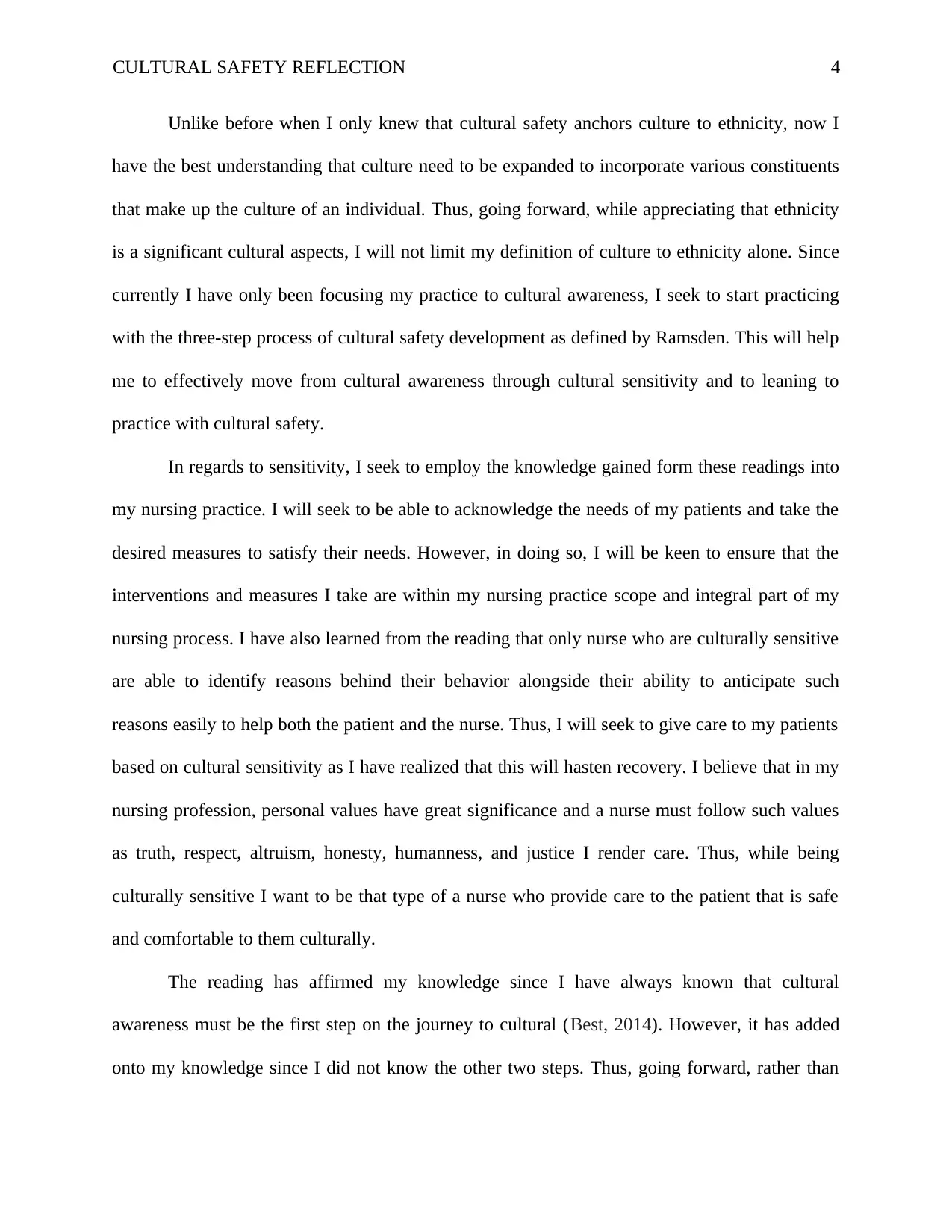
CULTURAL SAFETY REFLECTION 4
Unlike before when I only knew that cultural safety anchors culture to ethnicity, now I
have the best understanding that culture need to be expanded to incorporate various constituents
that make up the culture of an individual. Thus, going forward, while appreciating that ethnicity
is a significant cultural aspects, I will not limit my definition of culture to ethnicity alone. Since
currently I have only been focusing my practice to cultural awareness, I seek to start practicing
with the three-step process of cultural safety development as defined by Ramsden. This will help
me to effectively move from cultural awareness through cultural sensitivity and to leaning to
practice with cultural safety.
In regards to sensitivity, I seek to employ the knowledge gained form these readings into
my nursing practice. I will seek to be able to acknowledge the needs of my patients and take the
desired measures to satisfy their needs. However, in doing so, I will be keen to ensure that the
interventions and measures I take are within my nursing practice scope and integral part of my
nursing process. I have also learned from the reading that only nurse who are culturally sensitive
are able to identify reasons behind their behavior alongside their ability to anticipate such
reasons easily to help both the patient and the nurse. Thus, I will seek to give care to my patients
based on cultural sensitivity as I have realized that this will hasten recovery. I believe that in my
nursing profession, personal values have great significance and a nurse must follow such values
as truth, respect, altruism, honesty, humanness, and justice I render care. Thus, while being
culturally sensitive I want to be that type of a nurse who provide care to the patient that is safe
and comfortable to them culturally.
The reading has affirmed my knowledge since I have always known that cultural
awareness must be the first step on the journey to cultural (Best, 2014). However, it has added
onto my knowledge since I did not know the other two steps. Thus, going forward, rather than
Unlike before when I only knew that cultural safety anchors culture to ethnicity, now I
have the best understanding that culture need to be expanded to incorporate various constituents
that make up the culture of an individual. Thus, going forward, while appreciating that ethnicity
is a significant cultural aspects, I will not limit my definition of culture to ethnicity alone. Since
currently I have only been focusing my practice to cultural awareness, I seek to start practicing
with the three-step process of cultural safety development as defined by Ramsden. This will help
me to effectively move from cultural awareness through cultural sensitivity and to leaning to
practice with cultural safety.
In regards to sensitivity, I seek to employ the knowledge gained form these readings into
my nursing practice. I will seek to be able to acknowledge the needs of my patients and take the
desired measures to satisfy their needs. However, in doing so, I will be keen to ensure that the
interventions and measures I take are within my nursing practice scope and integral part of my
nursing process. I have also learned from the reading that only nurse who are culturally sensitive
are able to identify reasons behind their behavior alongside their ability to anticipate such
reasons easily to help both the patient and the nurse. Thus, I will seek to give care to my patients
based on cultural sensitivity as I have realized that this will hasten recovery. I believe that in my
nursing profession, personal values have great significance and a nurse must follow such values
as truth, respect, altruism, honesty, humanness, and justice I render care. Thus, while being
culturally sensitive I want to be that type of a nurse who provide care to the patient that is safe
and comfortable to them culturally.
The reading has affirmed my knowledge since I have always known that cultural
awareness must be the first step on the journey to cultural (Best, 2014). However, it has added
onto my knowledge since I did not know the other two steps. Thus, going forward, rather than
Paraphrase This Document
Need a fresh take? Get an instant paraphrase of this document with our AI Paraphraser
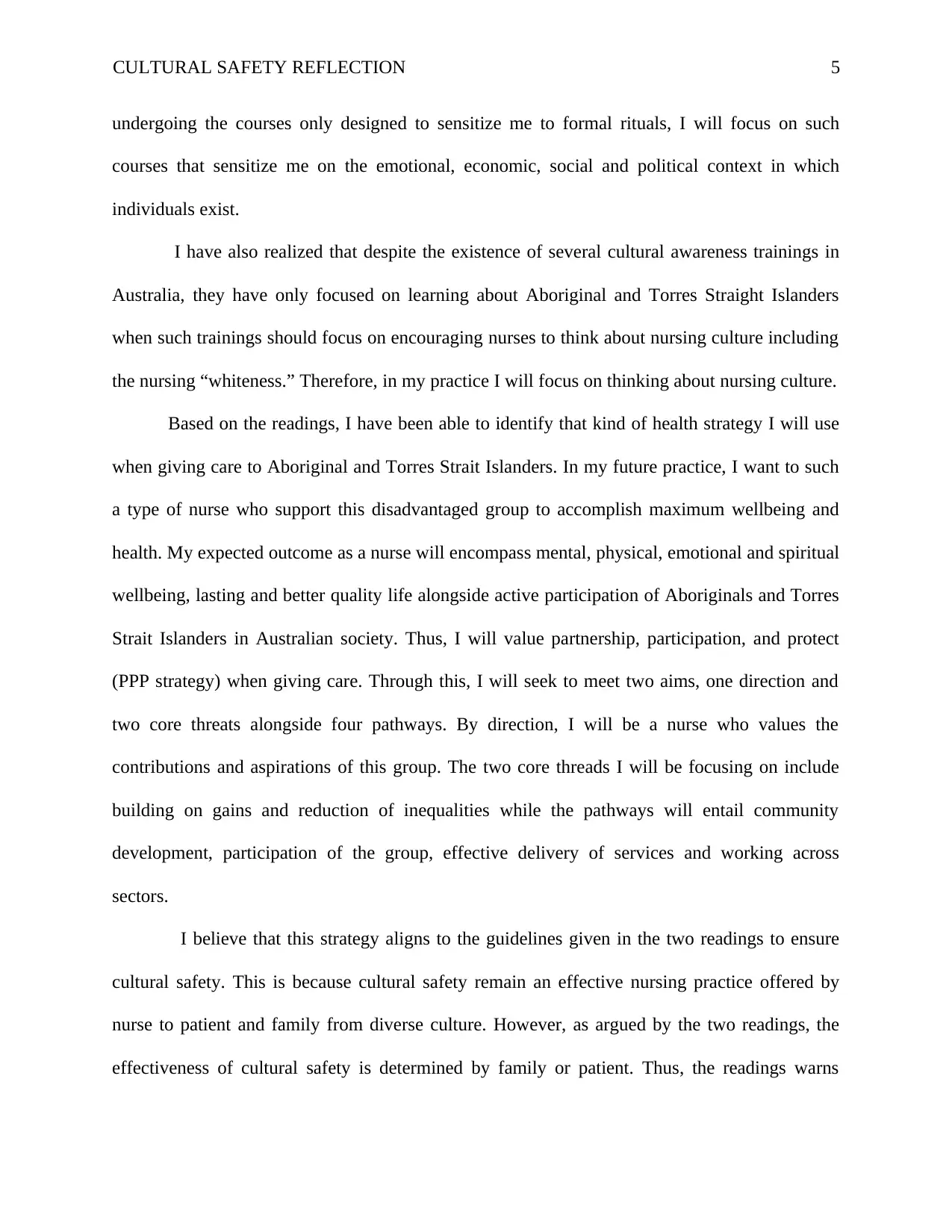
CULTURAL SAFETY REFLECTION 5
undergoing the courses only designed to sensitize me to formal rituals, I will focus on such
courses that sensitize me on the emotional, economic, social and political context in which
individuals exist.
I have also realized that despite the existence of several cultural awareness trainings in
Australia, they have only focused on learning about Aboriginal and Torres Straight Islanders
when such trainings should focus on encouraging nurses to think about nursing culture including
the nursing “whiteness.” Therefore, in my practice I will focus on thinking about nursing culture.
Based on the readings, I have been able to identify that kind of health strategy I will use
when giving care to Aboriginal and Torres Strait Islanders. In my future practice, I want to such
a type of nurse who support this disadvantaged group to accomplish maximum wellbeing and
health. My expected outcome as a nurse will encompass mental, physical, emotional and spiritual
wellbeing, lasting and better quality life alongside active participation of Aboriginals and Torres
Strait Islanders in Australian society. Thus, I will value partnership, participation, and protect
(PPP strategy) when giving care. Through this, I will seek to meet two aims, one direction and
two core threats alongside four pathways. By direction, I will be a nurse who values the
contributions and aspirations of this group. The two core threads I will be focusing on include
building on gains and reduction of inequalities while the pathways will entail community
development, participation of the group, effective delivery of services and working across
sectors.
I believe that this strategy aligns to the guidelines given in the two readings to ensure
cultural safety. This is because cultural safety remain an effective nursing practice offered by
nurse to patient and family from diverse culture. However, as argued by the two readings, the
effectiveness of cultural safety is determined by family or patient. Thus, the readings warns
undergoing the courses only designed to sensitize me to formal rituals, I will focus on such
courses that sensitize me on the emotional, economic, social and political context in which
individuals exist.
I have also realized that despite the existence of several cultural awareness trainings in
Australia, they have only focused on learning about Aboriginal and Torres Straight Islanders
when such trainings should focus on encouraging nurses to think about nursing culture including
the nursing “whiteness.” Therefore, in my practice I will focus on thinking about nursing culture.
Based on the readings, I have been able to identify that kind of health strategy I will use
when giving care to Aboriginal and Torres Strait Islanders. In my future practice, I want to such
a type of nurse who support this disadvantaged group to accomplish maximum wellbeing and
health. My expected outcome as a nurse will encompass mental, physical, emotional and spiritual
wellbeing, lasting and better quality life alongside active participation of Aboriginals and Torres
Strait Islanders in Australian society. Thus, I will value partnership, participation, and protect
(PPP strategy) when giving care. Through this, I will seek to meet two aims, one direction and
two core threats alongside four pathways. By direction, I will be a nurse who values the
contributions and aspirations of this group. The two core threads I will be focusing on include
building on gains and reduction of inequalities while the pathways will entail community
development, participation of the group, effective delivery of services and working across
sectors.
I believe that this strategy aligns to the guidelines given in the two readings to ensure
cultural safety. This is because cultural safety remain an effective nursing practice offered by
nurse to patient and family from diverse culture. However, as argued by the two readings, the
effectiveness of cultural safety is determined by family or patient. Thus, the readings warns
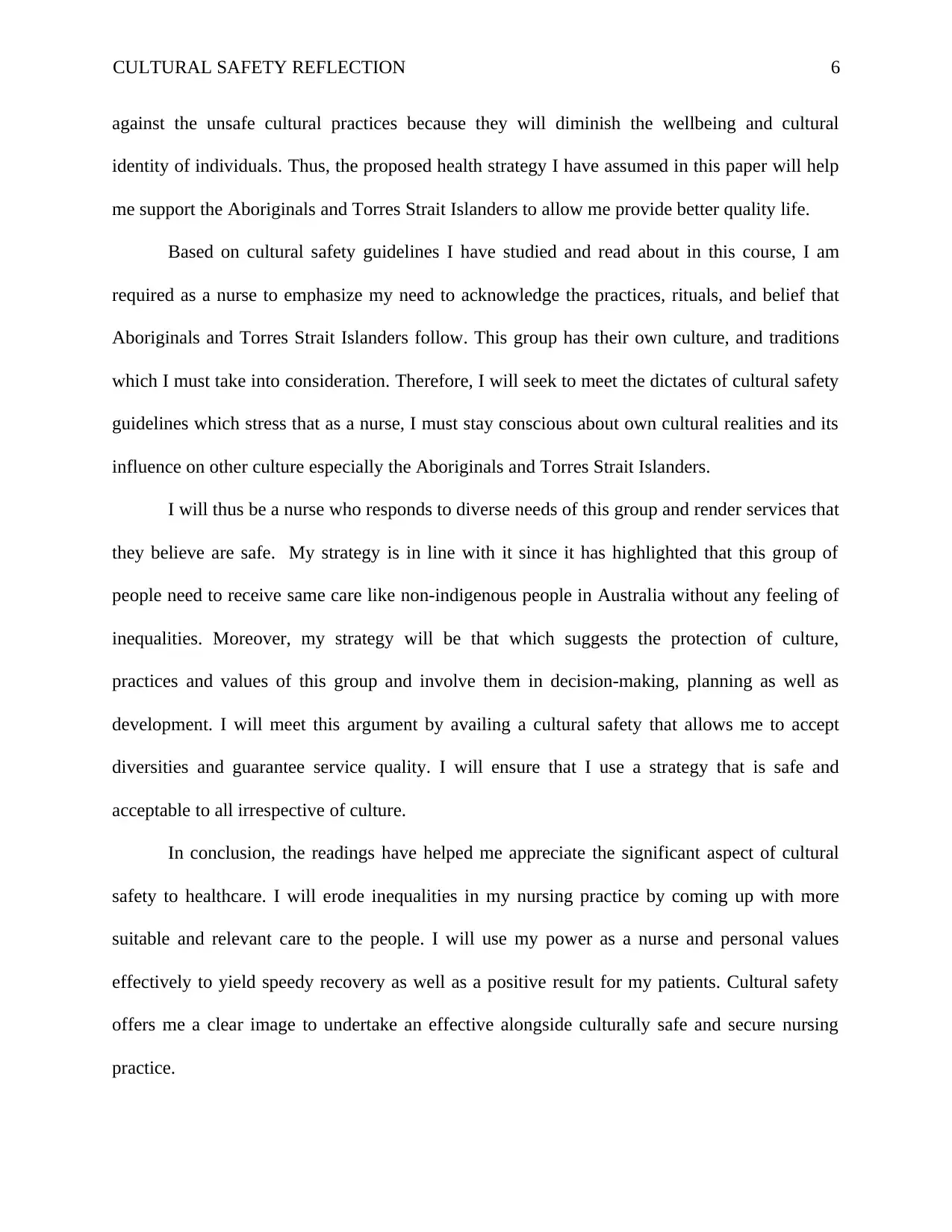
CULTURAL SAFETY REFLECTION 6
against the unsafe cultural practices because they will diminish the wellbeing and cultural
identity of individuals. Thus, the proposed health strategy I have assumed in this paper will help
me support the Aboriginals and Torres Strait Islanders to allow me provide better quality life.
Based on cultural safety guidelines I have studied and read about in this course, I am
required as a nurse to emphasize my need to acknowledge the practices, rituals, and belief that
Aboriginals and Torres Strait Islanders follow. This group has their own culture, and traditions
which I must take into consideration. Therefore, I will seek to meet the dictates of cultural safety
guidelines which stress that as a nurse, I must stay conscious about own cultural realities and its
influence on other culture especially the Aboriginals and Torres Strait Islanders.
I will thus be a nurse who responds to diverse needs of this group and render services that
they believe are safe. My strategy is in line with it since it has highlighted that this group of
people need to receive same care like non-indigenous people in Australia without any feeling of
inequalities. Moreover, my strategy will be that which suggests the protection of culture,
practices and values of this group and involve them in decision-making, planning as well as
development. I will meet this argument by availing a cultural safety that allows me to accept
diversities and guarantee service quality. I will ensure that I use a strategy that is safe and
acceptable to all irrespective of culture.
In conclusion, the readings have helped me appreciate the significant aspect of cultural
safety to healthcare. I will erode inequalities in my nursing practice by coming up with more
suitable and relevant care to the people. I will use my power as a nurse and personal values
effectively to yield speedy recovery as well as a positive result for my patients. Cultural safety
offers me a clear image to undertake an effective alongside culturally safe and secure nursing
practice.
against the unsafe cultural practices because they will diminish the wellbeing and cultural
identity of individuals. Thus, the proposed health strategy I have assumed in this paper will help
me support the Aboriginals and Torres Strait Islanders to allow me provide better quality life.
Based on cultural safety guidelines I have studied and read about in this course, I am
required as a nurse to emphasize my need to acknowledge the practices, rituals, and belief that
Aboriginals and Torres Strait Islanders follow. This group has their own culture, and traditions
which I must take into consideration. Therefore, I will seek to meet the dictates of cultural safety
guidelines which stress that as a nurse, I must stay conscious about own cultural realities and its
influence on other culture especially the Aboriginals and Torres Strait Islanders.
I will thus be a nurse who responds to diverse needs of this group and render services that
they believe are safe. My strategy is in line with it since it has highlighted that this group of
people need to receive same care like non-indigenous people in Australia without any feeling of
inequalities. Moreover, my strategy will be that which suggests the protection of culture,
practices and values of this group and involve them in decision-making, planning as well as
development. I will meet this argument by availing a cultural safety that allows me to accept
diversities and guarantee service quality. I will ensure that I use a strategy that is safe and
acceptable to all irrespective of culture.
In conclusion, the readings have helped me appreciate the significant aspect of cultural
safety to healthcare. I will erode inequalities in my nursing practice by coming up with more
suitable and relevant care to the people. I will use my power as a nurse and personal values
effectively to yield speedy recovery as well as a positive result for my patients. Cultural safety
offers me a clear image to undertake an effective alongside culturally safe and secure nursing
practice.
⊘ This is a preview!⊘
Do you want full access?
Subscribe today to unlock all pages.

Trusted by 1+ million students worldwide
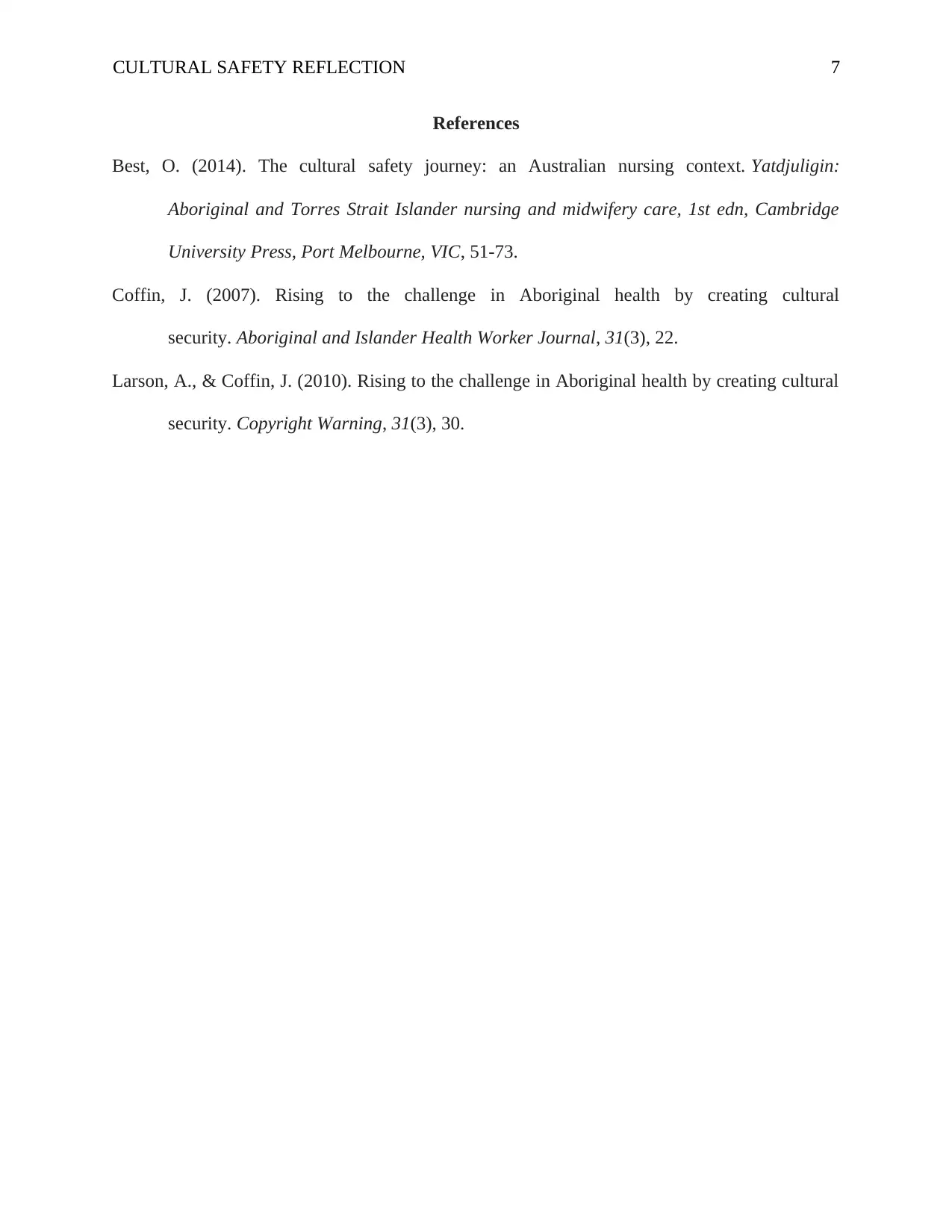
CULTURAL SAFETY REFLECTION 7
References
Best, O. (2014). The cultural safety journey: an Australian nursing context. Yatdjuligin:
Aboriginal and Torres Strait Islander nursing and midwifery care, 1st edn, Cambridge
University Press, Port Melbourne, VIC, 51-73.
Coffin, J. (2007). Rising to the challenge in Aboriginal health by creating cultural
security. Aboriginal and Islander Health Worker Journal, 31(3), 22.
Larson, A., & Coffin, J. (2010). Rising to the challenge in Aboriginal health by creating cultural
security. Copyright Warning, 31(3), 30.
References
Best, O. (2014). The cultural safety journey: an Australian nursing context. Yatdjuligin:
Aboriginal and Torres Strait Islander nursing and midwifery care, 1st edn, Cambridge
University Press, Port Melbourne, VIC, 51-73.
Coffin, J. (2007). Rising to the challenge in Aboriginal health by creating cultural
security. Aboriginal and Islander Health Worker Journal, 31(3), 22.
Larson, A., & Coffin, J. (2010). Rising to the challenge in Aboriginal health by creating cultural
security. Copyright Warning, 31(3), 30.
1 out of 7
Related Documents
Your All-in-One AI-Powered Toolkit for Academic Success.
+13062052269
info@desklib.com
Available 24*7 on WhatsApp / Email
![[object Object]](/_next/static/media/star-bottom.7253800d.svg)
Unlock your academic potential
Copyright © 2020–2025 A2Z Services. All Rights Reserved. Developed and managed by ZUCOL.





